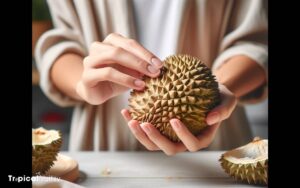How to Make Durian Cake? 9 Easy Steps!
Creating a durian cake is a delightful endeavor for those who savor the unique flavor of durian fruit. It involves selecting a ripe durian, extracting its flesh, and mixing it with traditional cake ingredients.
The baking process requires precision, resulting in a moist sponge that pairs perfectly with the rich durian filling. The final touches of layering, frosting, and decorating not only enhance the cake’s appearance but also its taste.
Proper storage ensures that the cake maintains its desired qualities until it’s ready to be served and enjoyed.
Here are some quick steps:
For example, the cake batter may include ingredients like flour, eggs, sugar, and butter, mixed using a stand mixer. The durian filling might be made by blending durian flesh with cream and sugar.
Experience the fusion of exotic durian and classic cake with this mouth-watering durian cake recipe.
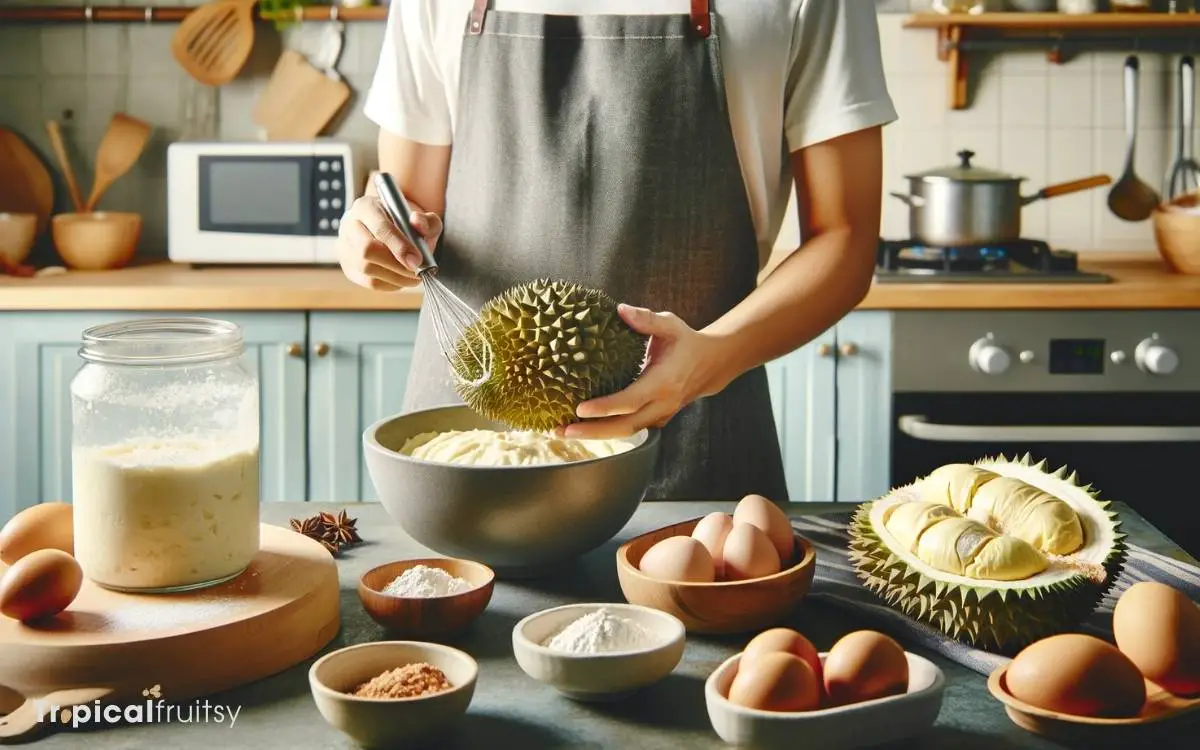
Key Takeaway
Step 1: Selecting Quality Durian

Choosing the right durian is crucial for the flavor and texture of your cake. Look for fruit with firm stems and a strong, sweet aroma.
When selecting quality durian, it is essential to assess the exterior for any pronounced blemishes or irregularities that may indicate inferior quality.
The fruit should exhibit a rich, golden hue and the spikes, while sharp, should not appear desiccated or brittle. Gently pressing on the husk can reveal the yielding nature of the flesh inside, suggestive of ripeness.
Moreover, a mature durian will emit a distinctively potent fragrance—an amalgam of sweet, creamy notes with a touch of almond.
This olfactory cue is a reliable indicator of the readiness for culinary use. Carefully chosen, your durian is now ready for the next step: preparing the durian flesh.
Step 2: Preparing the Durian Flesh
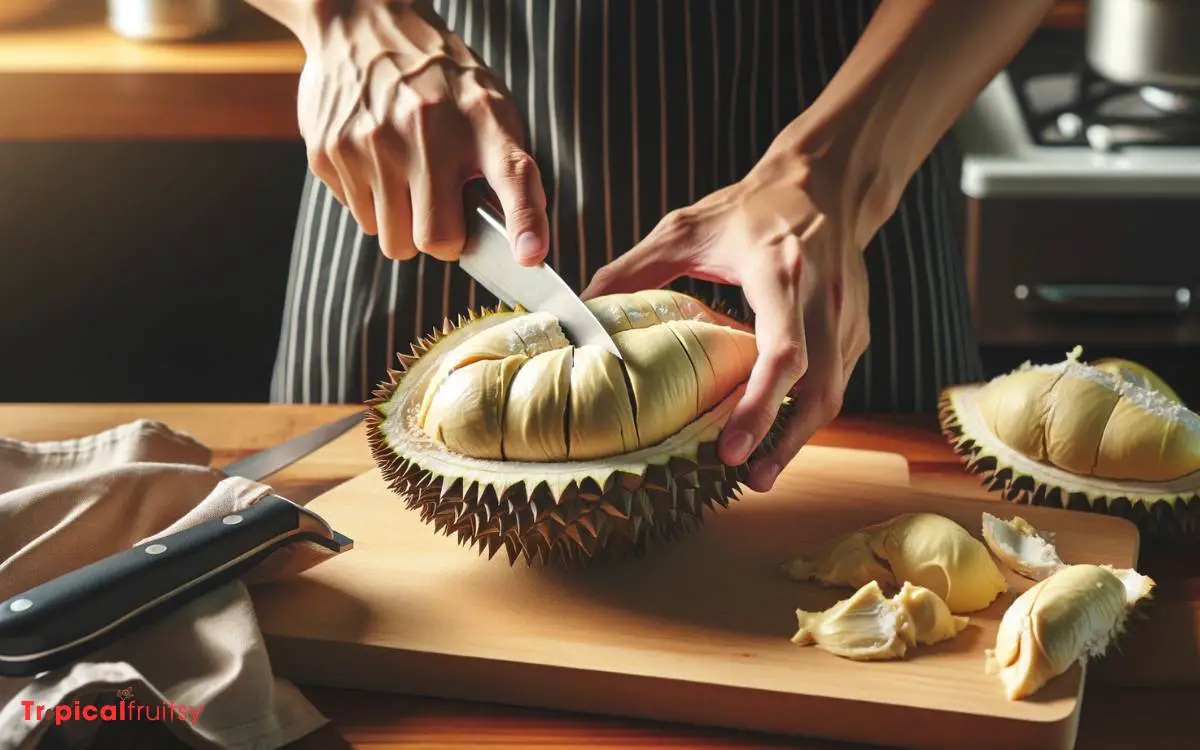
Prior to integrating the durian into our cake batter, meticulous preparation of its flesh is paramount. The initial step involves the careful extraction of the creamy pulp, ensuring the preservation of its texture and aroma.
Subsequent to pulp retrieval, one must employ adept techniques for the removal of seeds, maintaining the integrity of the fruit for optimal flavor infusion.
Durian Flesh Extraction
Typically, the first step in crafting a durian cake involves the careful extraction of the fruit’s creamy flesh, ensuring it is free from seeds and fibers.
This process is crucial as the purity and texture of the durian flesh significantly influence the flavor profile and consistency of the final cake.
To emphasize the technique and precision required for this process, consider the following table outlining the essential steps:
| Step | Description | Key Consideration |
|---|---|---|
| 1 | Slice durian along seams | Use a sharp knife |
| 2 | Pry open the sections | Avoid crushing the flesh |
| 3 | Remove seeds | Gently extract without residue |
| 4 | Scoop out flesh | Maintain integrity of the flesh |
| 5 | Strain or puree flesh | Ensure a smooth consistency |
This structured approach ensures that the durian flesh is perfectly prepared for incorporation into your exquisite durian cake.
Seed Removal Techniques
Once the durian is opened and the flesh exposed, careful seed removal is the next critical step to ensure a smooth durian cake batter.
The seeds of the durian are large and inedible, and they must be removed with precision to avoid waste and ensure the pure flavor of the fruit is captured in your cake.
Here are key techniques:
Using a paring knife:
- Gently slice into the flesh to create an opening.
- Wiggle the knife to loosen the seed.
- Lift out the seed and discard.
With your fingers:
- Press the flesh around the seed.
- Pinch the seed between your fingers and extract.
- Inspect the flesh for any remnants.
Utilizing a spoon:
- Scoop around the seed’s base.
- Leverage the spoon to pop the seed free.
- Check the cavity for any seed casing left behind.
Each method requires a blend of gentleness and firmness to maintain the integrity of the durian flesh, which is paramount for a velvety cake texture.
Step 3: Ingredients and Tools Needed
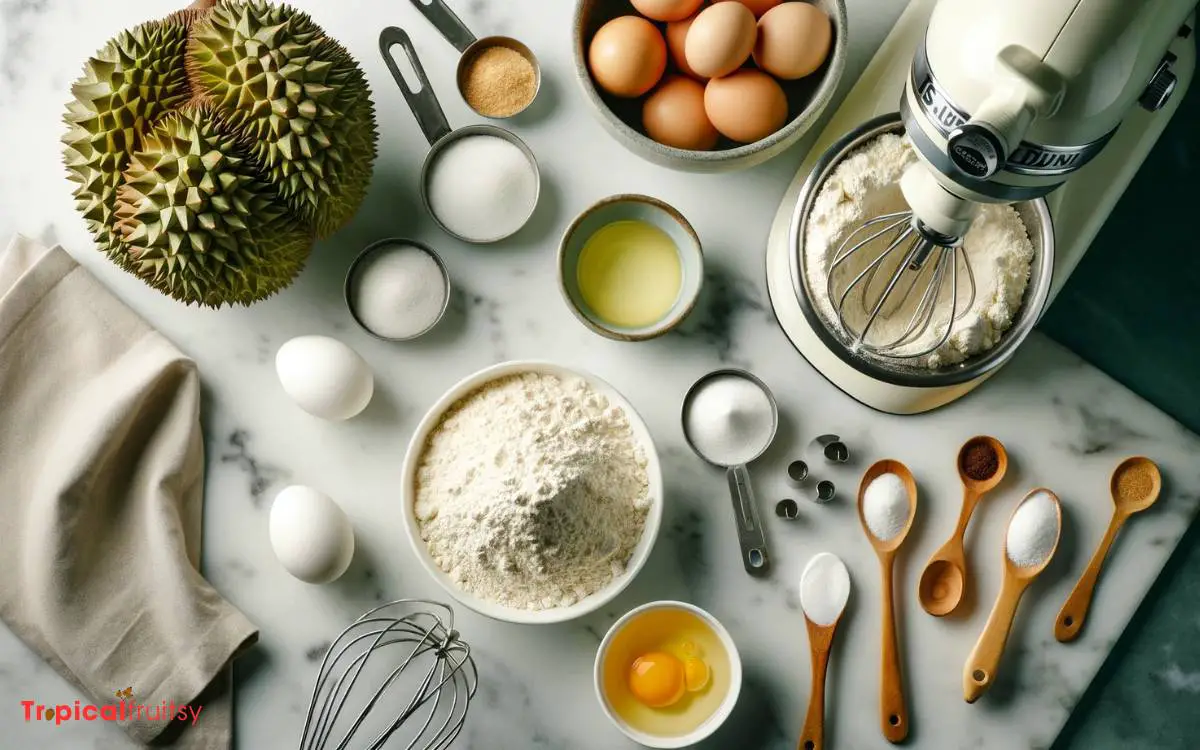
To prepare the distinctive durian cake, several key ingredients and specific baking tools are required.
The core components include fresh durian pulp, finely milled all-purpose flour, granulated sugar, unsalted butter, and farm-fresh eggs.
Additionally, baking powder and a pinch of salt are essential to ensure proper leavening and flavor balance. Precision in measurement is paramount, thus a digital scale is advised for accuracy.
A set of mixing bowls, a sieve for sifting, an electric mixer with paddle attachment, and a rubber spatula are indispensable for combining the ingredients homogeneously. Furthermore, a properly calibrated oven is critical for consistent baking.
Lastly, a springform pan lined with parchment paper will facilitate the cake’s release after cooling, preserving its delicate structure.
Step 4: Mixing the Cake Batter
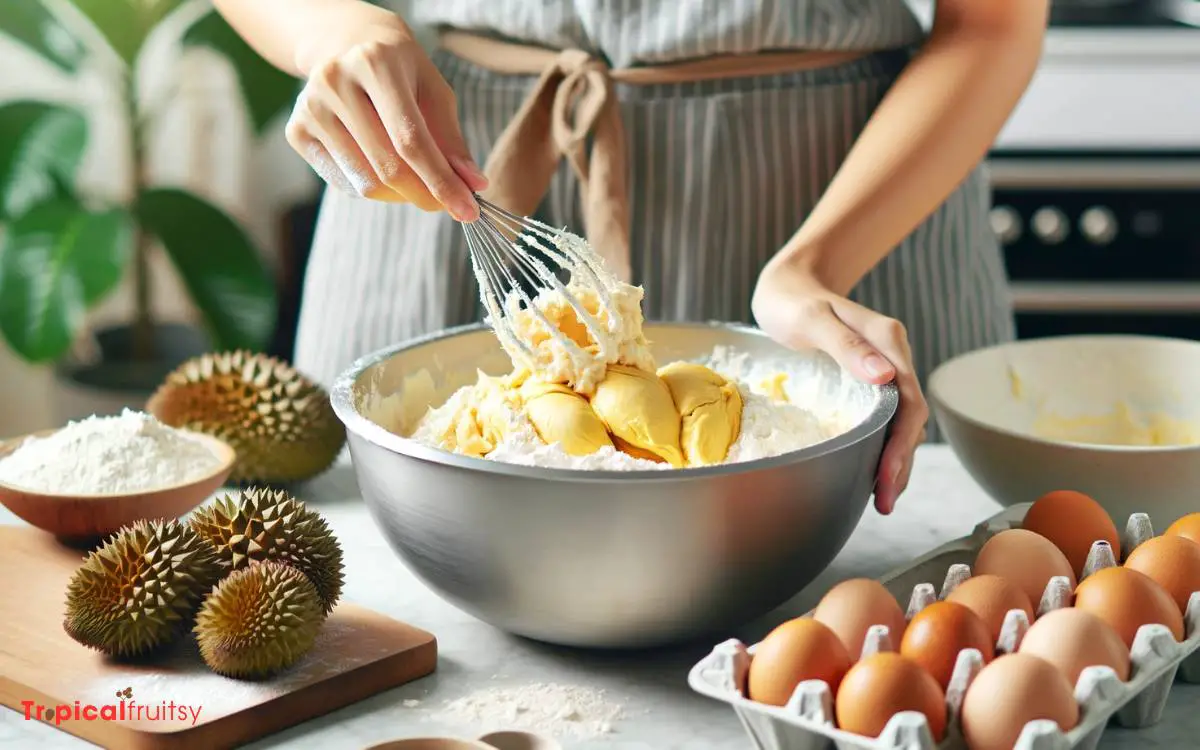
The amalgamation of the cake batter marks a critical phase in the creation of a durian cake, where the texture and flavor profile are set into motion.
Ensuring the durian puree is at an ideal consistency is paramount, as it affects the moisture balance and infusion of the cake’s distinctive taste.
Moreover, vigilance against overmixing is necessary to prevent gluten networks from overdeveloping, which can result in a dense and tough crumb structure.
Durian Puree Consistency
Achieving the correct consistency for durian puree is crucial when preparing your cake batter, as it influences the texture and flavor distribution of the final product.
The puree should be:
- Smooth and homogenous, without lumps
- Achieved by thorough blending or passing through a fine sieve
- Ensures even incorporation into the batter
- Not overly fluid
- Stabilized by a gentle thickening, if necessary, with a small amount of fine flour or cornstarch
- Prevents the batter from becoming too runny, which could affect the cake’s structure
- Rich and creamy
- Attained by selecting ripe durians with a naturally creamy pulp
- Contributes to the desired velvety texture within the baked cake
Precision in this step promises a cake that is both sumptuously aromatic and exquisitely tender.
Batter Overmixing Risks
During the process of mixing your durian cake batter, it is imperative to be mindful of overmixing, as this can lead to a dense and tough cake texture.
The ideal consistency is achieved when the ingredients are just amalgamated, ensuring the preservation of air pockets that contribute to the cake’s levity.
Vigilance is key; cease mixing once the flour streaks disappear and the durian puree is evenly distributed.
Overworking the batter develops the gluten excessively, resulting in a product that is devoid of the desired tender crumb. It is a delicate balance, a confluence of precision and restraint, that leads to the perfect cake structure.
With the batter now appropriately mixed, the focus shifts to the art of baking the perfect sponge.
Step 5: Baking the Perfect Sponge
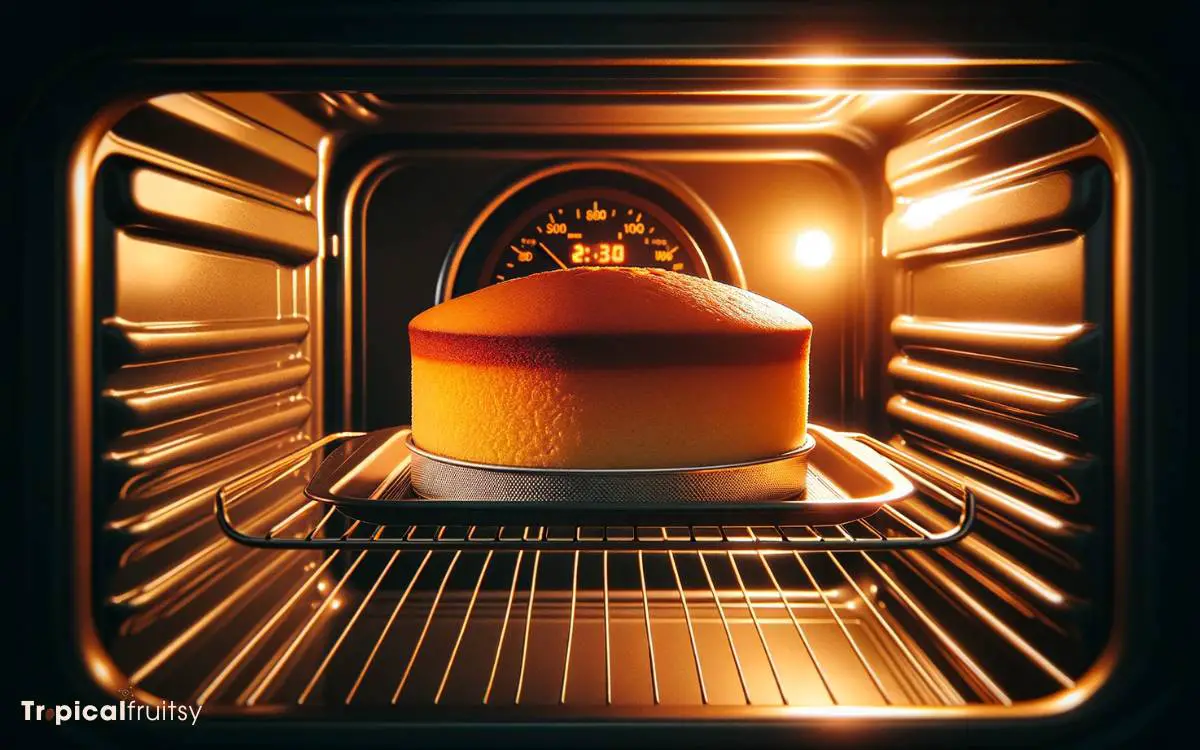
Crafting a flawless durian cake sponge necessitates precise attention to ingredient ratios and baking temperatures.
A mastery of the following steps will yield a sponge that is light, airy, and an ideal canvas for the rich durian filling:
Ingredients at Room Temperature:
- Eggs: Unleash their full volume potential.
- Butter: Ensures even distribution within the batter.
Gentle Folding Technique:
- Maintain airiness: Preserve the delicate structure.
- Even incorporation: No flour streaks for uniform texture.
Optimized Baking Environment:
- Preheated oven: A crucial step for consistent rising.
- Middle rack placement: Promotes even heat circulation.
Upon achieving a golden-brown hue and a springy touch, your sponge is ready to cool, setting the stage for crafting the durian filling.
Step 6: Crafting the Durian Filling
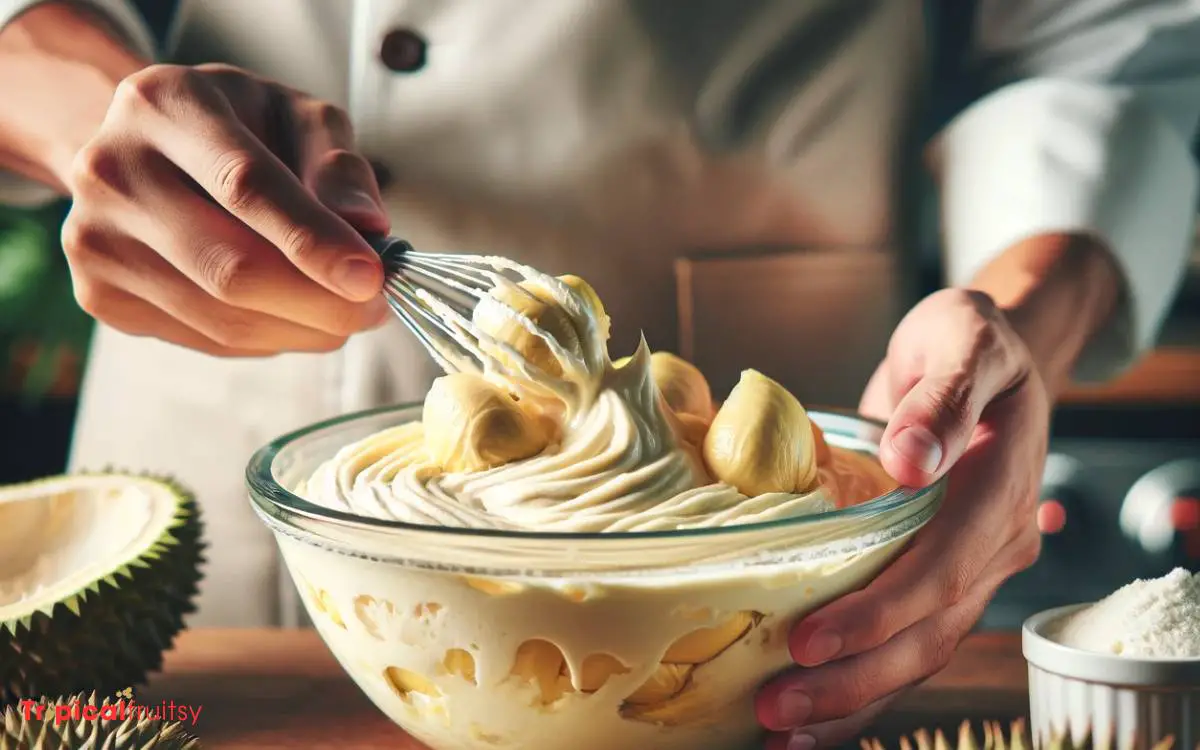
Once your sponge is set and cooled, it’s time to focus on the heart of the durian cake: the creamy, aromatic filling.
Begin by selecting the ripest durian fruit, known for its rich custard-like texture. Carefully extract the flesh, ensuring any hard segments or seeds are removed. For a smooth consistency, blend the pulp until homogenous.
In a separate vessel, whip heavy cream to soft peaks, incorporating a stabilizer like powdered gelatin pre-dissolved in warm water to ensure the filling holds its structure. Gently fold the durian puree into the whipped cream, creating a voluptuous emulsion.
If desired, enhance the filling’s depth with a hint of vanilla extract or a drizzle of honey. The resulting mixture should be a harmonious balance of tropical nuance and sumptuous creaminess, ready to enrobe the sponge layers.
Step 7: Assembling the Cake Layers
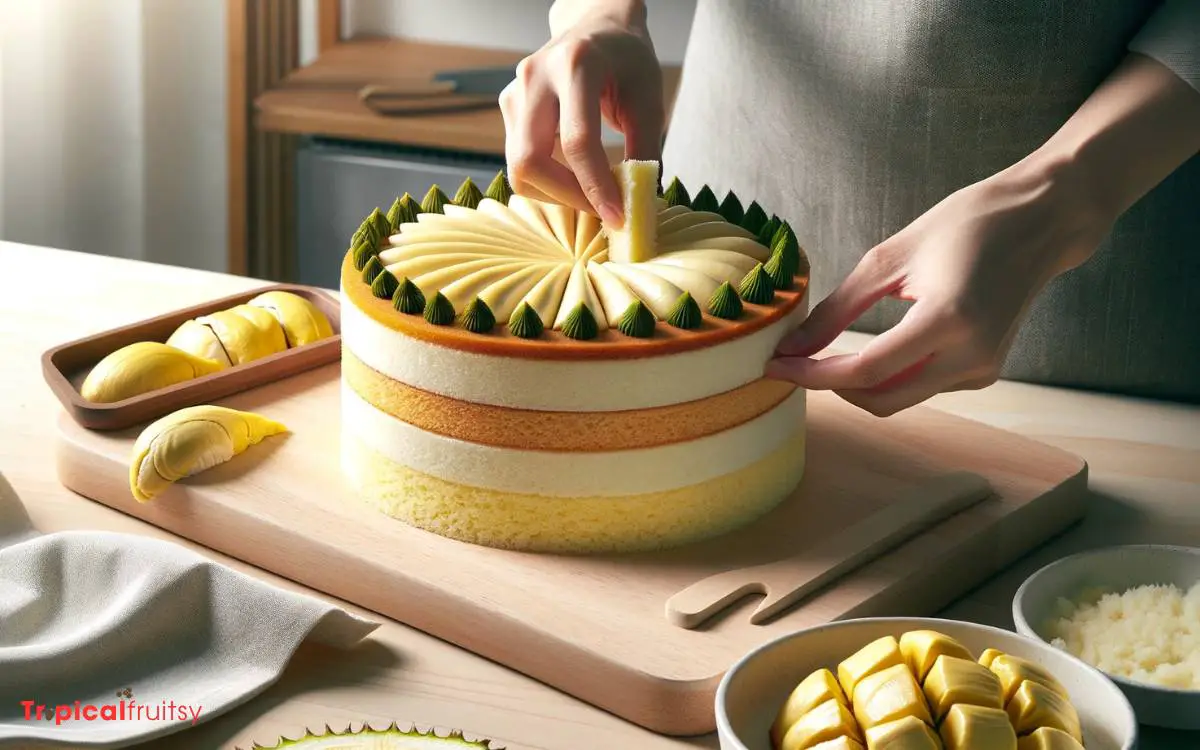
How can one skillfully layer the components to construct the quintessential durian cake? The art lies in precision and creativity, melding flavors and textures into a harmonious confection.
Begin with the sponge cake base:
- Ensure it is fully cooled to prevent the durian filling from melting.
- Trim the top to create a flat surface for stable layering.
Spread a generous amount of durian filling:
- Maintain a uniform thickness for each layer to distribute the durian flavor evenly.
- Reserve some filling for the exterior if a durian frosting is desired.
Add subsequent cake layers:
- Alternate between sponge cake and durian filling.
- Apply gentle pressure to adhere layers without compressing the cake’s delicate crumb.
Each step is a brushstroke in this edible masterpiece, appealing to connoisseurs of this unique fruit’s culinary potential.
Step 8: Frosting and Decoration Tips
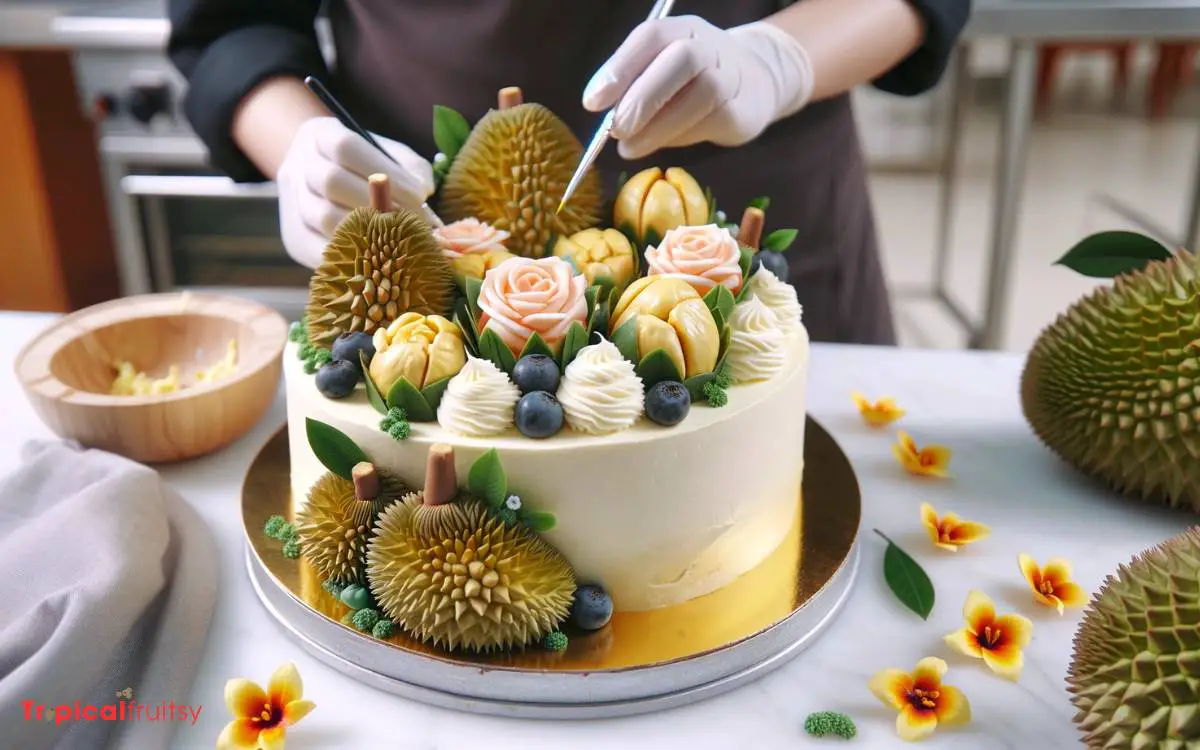
Apply a smooth layer of durian frosting over the assembled cake, using an offset spatula for even distribution and a professional finish. The consistency of the frosting should be malleable yet stable enough to maintain its shape.
For a touch of sophistication, employ the textured spatula technique to create swirls or patterns. This not only adds visual interest but also enhances the tactile experience of your creation.
| Technique | Description |
|---|---|
| Piping Details | Utilize a piping bag with a fine tip to add intricate borders or write messages on the cake. |
| Fresh Garnishes | Adorn with fresh durian slices or edible flowers for an organic, vibrant contrast. |
| Dusting | A light dusting of powdered sugar or coconut flakes can give a snowy, delicate finish. |
For a harmonious balance, ensure the decoration complements rather than overwhelms the durian flavor profile.
Step 9: Storing and Serving Suggestions
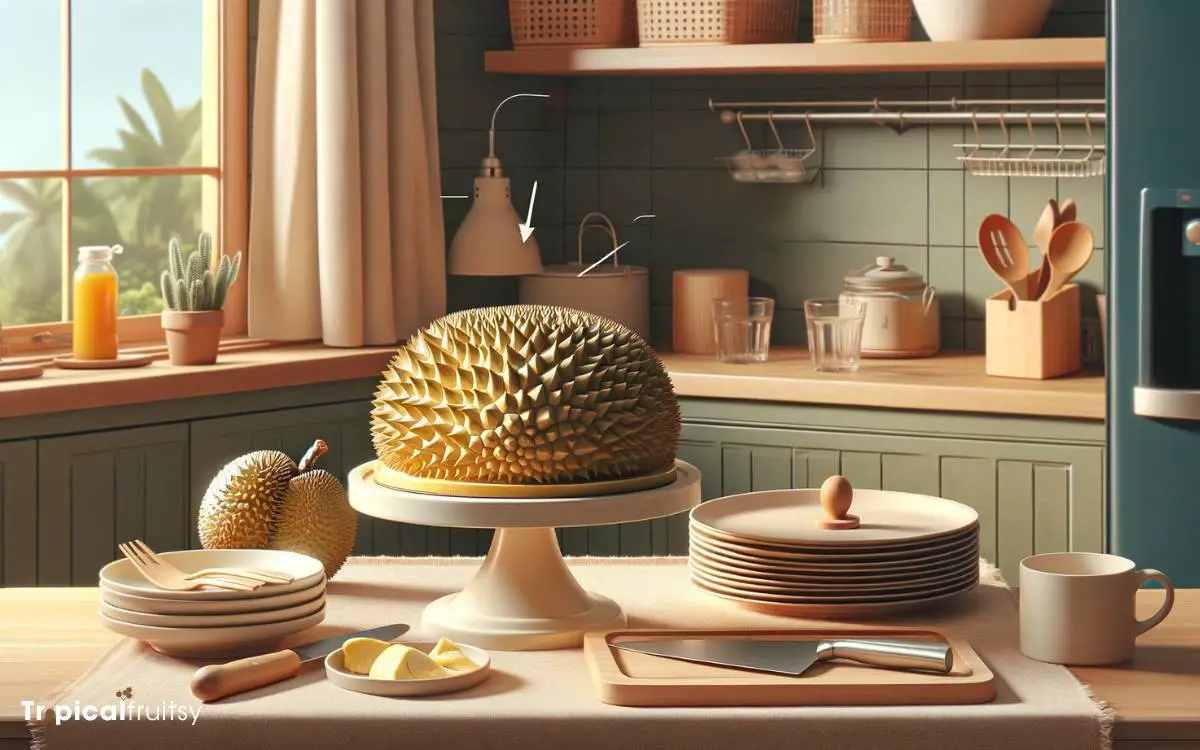
Ensuring your durian cake retains its freshness and flavor, proper storage is key after the decoration process is complete.
For optimal preservation, observe the following guidelines:
Refrigeration:
- Store the cake in an airtight container to prevent odor absorption.
- Keep at a consistent temperature, ideally between 2°C to 5°C.
Freezing (for long-term storage):
- Wrap cake slices individually in cling film and then in foil.
- Place wrapped slices in a heavy-duty freezer bag, expelling air before sealing.
Serving:
- Thaw frozen slices in the refrigerator overnight.
- Allow the chilled cake to sit at room temperature for 10-15 minutes before serving for enhanced flavor.
These measures will maintain the cake’s integrity, ensuring each bite offers the intended tropical indulgence.
How to Make Durian Cake Filling
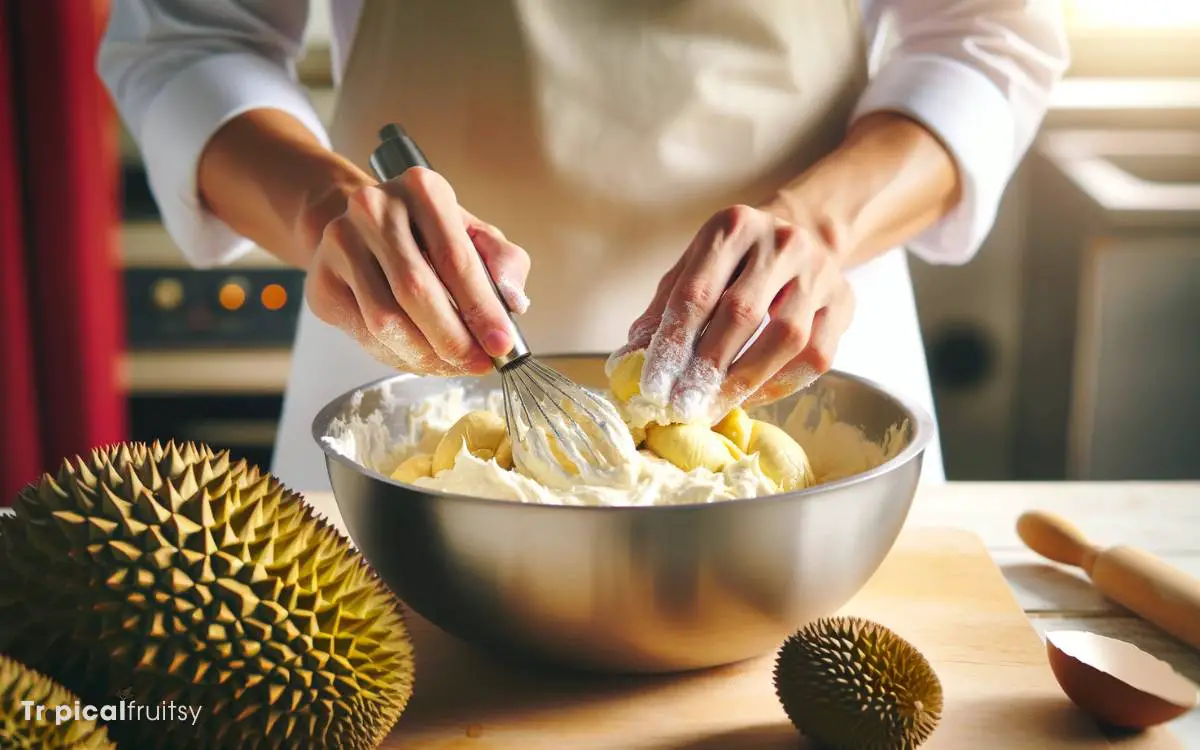
Durian cake filling is a delightful way to incorporate the unique flavor of durian into your baked goods.
Here’s a basic recipe to make durian cake filling:
Ingredients:
- 1 cup of ripe durian flesh (fresh or frozen)
- 1/4 cup of granulated sugar (adjust to taste)
- 1/4 cup of coconut milk or heavy cream (adjust consistency)
- 1 tablespoon of cornstarch (optional, for thickening)
- 1/4 teaspoon of vanilla extract (optional, for flavor)
Instructions:
Prepare the Durian Flesh:
- If you’re using fresh durian, remove the flesh from the fruit and discard the seeds and skin. If you’re using frozen durian, allow it to thaw at room temperature.
Blend the Durian:
- Place the durian flesh in a blender or food processor. Blend until you achieve a smooth puree. You may need to scrape down the sides of the blender to ensure all the chunks are fully blended.
Cook the Durian Puree:
- Transfer the durian puree to a saucepan. Cook it over medium-low heat, stirring continuously. This step helps to reduce excess moisture and intensify the flavor. Cook for about 5-10 minutes or until the puree thickens slightly.
Add Sugar:
- Stir in the granulated sugar to sweeten the durian filling. Adjust the amount of sugar to your taste preferences. Keep in mind that the sweetness of durian can vary, so taste as you go.
Add Coconut Milk or Heavy Cream:
- Pour in the coconut milk or heavy cream to achieve the desired consistency and creaminess. This will also help balance the richness of the durian. Adjust the amount to your liking.
Optional Thickening Agent:
- If you prefer a thicker filling, dissolve cornstarch in a small amount of cold water to create a slurry. Stir the slurry into the durian mixture and continue cooking until it thickens to your desired consistency.
Add Vanilla Extract (Optional):
- For added flavor, you can include a dash of vanilla extract. This step is optional but can enhance the overall taste of the filling.
Cool the Filling:
- Allow the durian cake filling to cool completely. You can transfer it to a bowl and refrigerate it for faster cooling.
Once your durian cake filling has cooled, it’s ready to be used in your cake. You can spread it between cake layers, use it as a filling for pastries, or incorporate it into various dessert recipes to enjoy the unique and delicious flavor of durian.
Conclusion
The art of crafting a durian cake necessitates meticulous attention to detail and adroit culinary skills.
By carefully selecting the choicest fruit, preparing the succulent durian flesh, and methodically mixing a rich batter, one constructs a cake that is both aromatic and flavorful.
Assembling the layers with a luxurious durian filling and adorning it with finesse, the confection becomes a palatable tapestry of the past, replete with contemporary gastronomic delight.

